
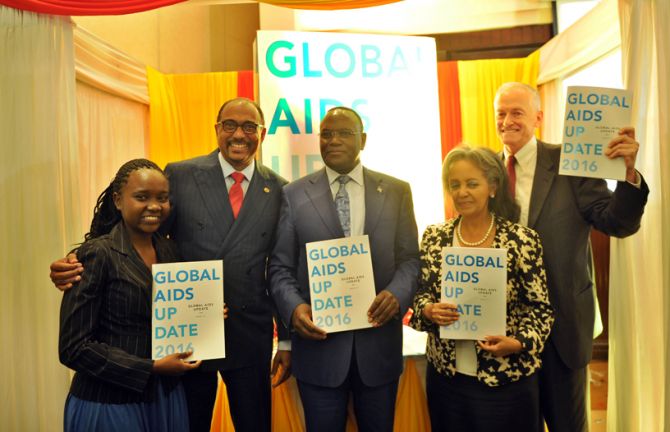
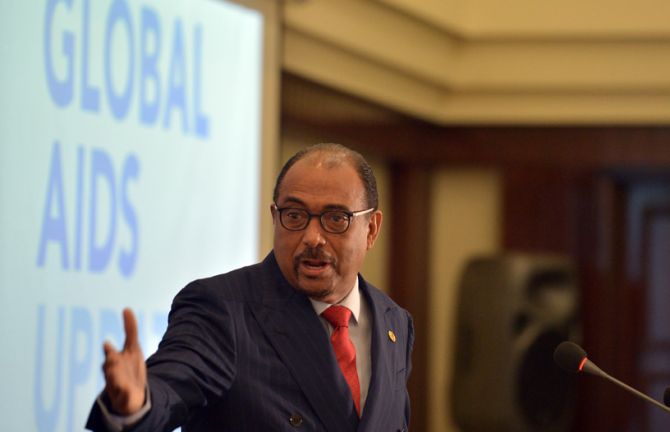
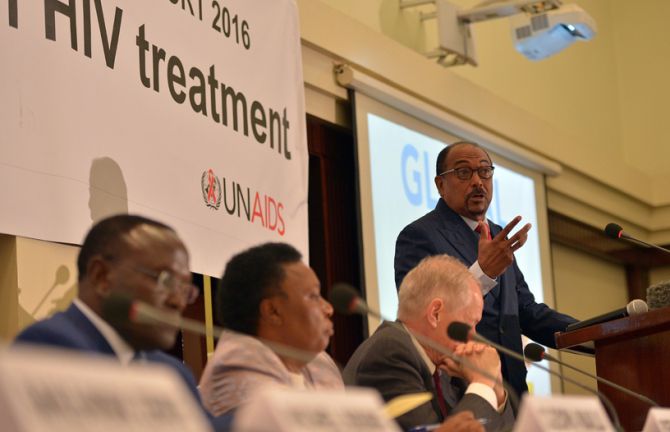
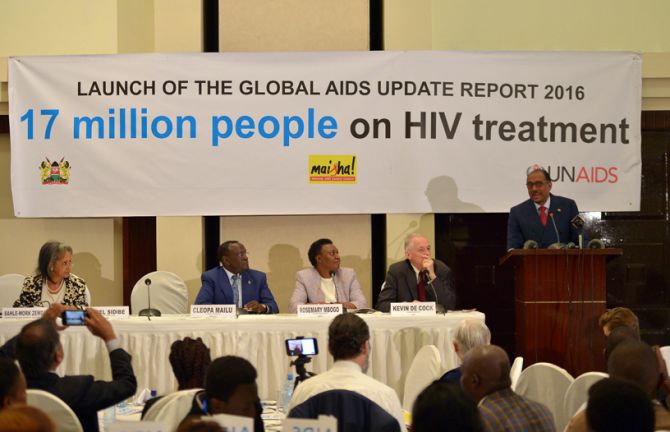
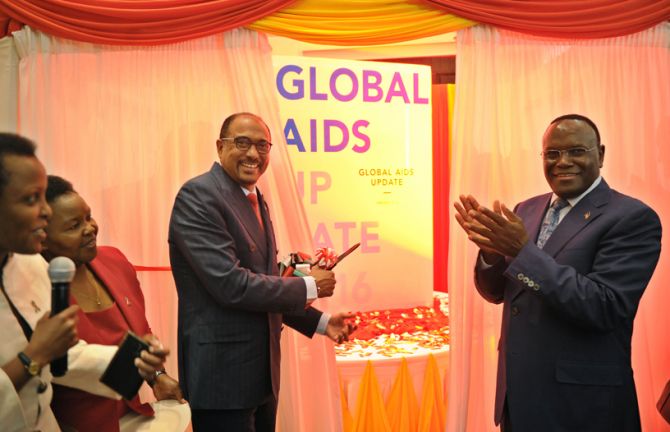
Press Release
UNAIDS announces 2 million more people living with HIV on treatment in 2015, bringing new total to 17 million
30 May 2016 30 May 2016New report from UNAIDS shows that the number of people accessing antiretroviral medicines has more than doubled since 2010
GENEVA/NAIROBI, 31 May 2016—An estimated 17 million people were accessing life-saving antiretroviral medicines at the end of 2015, with an additional 2 million people gaining access over a 12-month period. The announcement, made in a new UNAIDS report entitled Global AIDS update 2016, comes as world leaders prepare to gather for the United Nations General Assembly High-Level Meeting on Ending AIDS, to take place in New York, United States of America, from 8 to 10 June 2016.
The extraordinary scale-up of antiretroviral treatment since 2010 by many of the world’s most affected countries has reduced AIDS-related deaths from 1.5 million in 2010 [1.3 million–1.7 million] to 1.1 million [940 000–1.3 million] in 2015. As more countries adopt new guidelines from the World Health Organization to treat everyone diagnosed with HIV immediately, public health benefits are being realized for individuals and for wider society.
“The full potential of antiretroviral therapy is being realized,” said Michel Sidibé, Executive Director of UNAIDS. “I urge all countries to seize this unprecedented opportunity to put HIV prevention and treatment programmes on the Fast-Track and end the AIDS epidemic by 2030.”
Global coverage of antiretroviral therapy reached 46% [43–50%] at the end of 2015. Gains were greatest in the world’s most affected region, eastern and southern Africa, where coverage increased from 24% [22–25%] in 2010 to 54% [50–58%] in 2015, reaching a total of 10.3 million people. In South Africa, 3.4 million people had access to treatment, followed by Kenya with nearly 900 000. Botswana, Eritrea, Kenya, Malawi, Mozambique, Rwanda, South Africa, Swaziland, Uganda, the United Republic of Tanzania, Zambia and Zimbabwe all increased treatment coverage by more than 25 percentage points between 2010 and 2015.
The report was launched in Nairobi, Kenya, one of the countries showing the most remarkable progress in expanding access to antiretroviral medicines and reducing the number of new HIV infections.
“The Kenyan government, in partnership with UNAIDS and other development partners, is committed to the Fast-Track approach to ending AIDS as a public health threat by 2030,” said Cleopa Mailu, Kenya’s Cabinet Secretary for Health. “We must catalyse investments across different sectors, with a focus on cost-effective and socially inclusive programmes, if we are to succeed.”
The UNAIDS Fast-Track approach to treatment is proven to work in countries adopting it. The momentum must continue to achieve the UNAIDS 90–90–90 treatment target by 2020, whereby 90% of people living with HIV know their status, 90% of people who know their HIV-positive status are accessing treatment and 90% of people on treatment have suppressed viral loads. Reaching the 2020 treatment target will set the world on course to end the AIDS epidemic by 2030 as part of the Sustainable Development Goals.
Reinvigorating HIV prevention
Preventing new HIV infections by countering stigma and discrimination and ensuring that 90% of people have access to HIV combination prevention services will also be crucial to ending the AIDS epidemic.
The UNAIDS report shows that declines in new HIV infections among adults have slowed alarmingly in recent years, with the estimated annual number of new infections among adults remaining nearly static at about 1.9 million [1.7 million–2.2 million]. The global figure masks striking regional disparities that must be addressed to achieve the reductions required to end the AIDS epidemic by 2030.
The largest reduction in new adult infections occurred in eastern and southern Africa. There were about 40 000 fewer adult HIV infections in the region in 2015 than in 2010, a 4% decline. More gradual declines were achieved in the Asia and Pacific region and western and central Africa. Rates of new adult HIV infections were relatively stable in Latin America and the Caribbean, western and central Europe, North America, the Middle East and North Africa. However, the annual number of new HIV infections in eastern Europe and central Asia increased by 57%.
People being left behind
In the report, UNAIDS urges countries to continue to scale up HIV prevention efforts while continuing to roll out treatment, since many people are still not being reached. Young people and adolescents, especially young women and girls, are still being left behind in the AIDS response. Adolescent girls and young women 15–24 years old are at higher risk of HIV infection globally, accounting for 20% of new HIV infections among adults globally in 2015, despite accounting for just 11% of the adult population. In sub-Saharan Africa, adolescent girls and young women account for 25% new HIV infections among adults. Harmful gender norms and inequalities, obstacles to education and sexual and reproductive health services, poverty, food insecurity and violence are the key drivers of this increased vulnerability.
The report also shows that more than 90% of new HIV infections in central Asia, Europe, North America, the Middle East and North Africa in 2014 were among people from key populations and their sexual partners, including gay men and other men who have sex with men, sex workers and people who inject drugs. In sub-Saharan Africa, key populations accounted for more than 20% of new HIV infections. These groups of people are still not being reached with HIV prevention and treatment services despite having the highest rates of HIV prevalence.
The report urges countries to work closely with partners, particularly civil society, communities and people living with HIV, to ensure that they know where their epidemics are concentrated and that they have the right services in the right places.
“We need a people-centred response to the AIDS epidemic that removes all obstacles in the path of people’s access to HIV prevention and treatment services,” said Mr Sidibé. “These services must be fully funded and appropriate to people’s needs so that we can end the AIDS epidemic for everybody.”
The report outlines that science, evidence and policy have opened up a unique opportunity to end the AIDS epidemic by 2030 as part of the Sustainable Development Goals. The global community has to unite around this common goal to realize the full potential of the opportunities or risk the epidemic being prolonged indefinitely.
UNAIDS
The Joint United Nations Programme on HIV/AIDS (UNAIDS) leads and inspires the world to achieve its shared vision of zero new HIV infections, zero discrimination and zero AIDS-related deaths. UNAIDS unites the efforts of 11 UN organizations—UNHCR, UNICEF, WFP, UNDP, UNFPA, UNODC, UN Women, ILO, UNESCO, WHO and the World Bank—and works closely with global and national partners towards ending the AIDS epidemic by 2030 as part of the Sustainable Development Goals. Learn more at unaids.org and connect with us on Facebook, Twitter, Instagram and YouTube.
